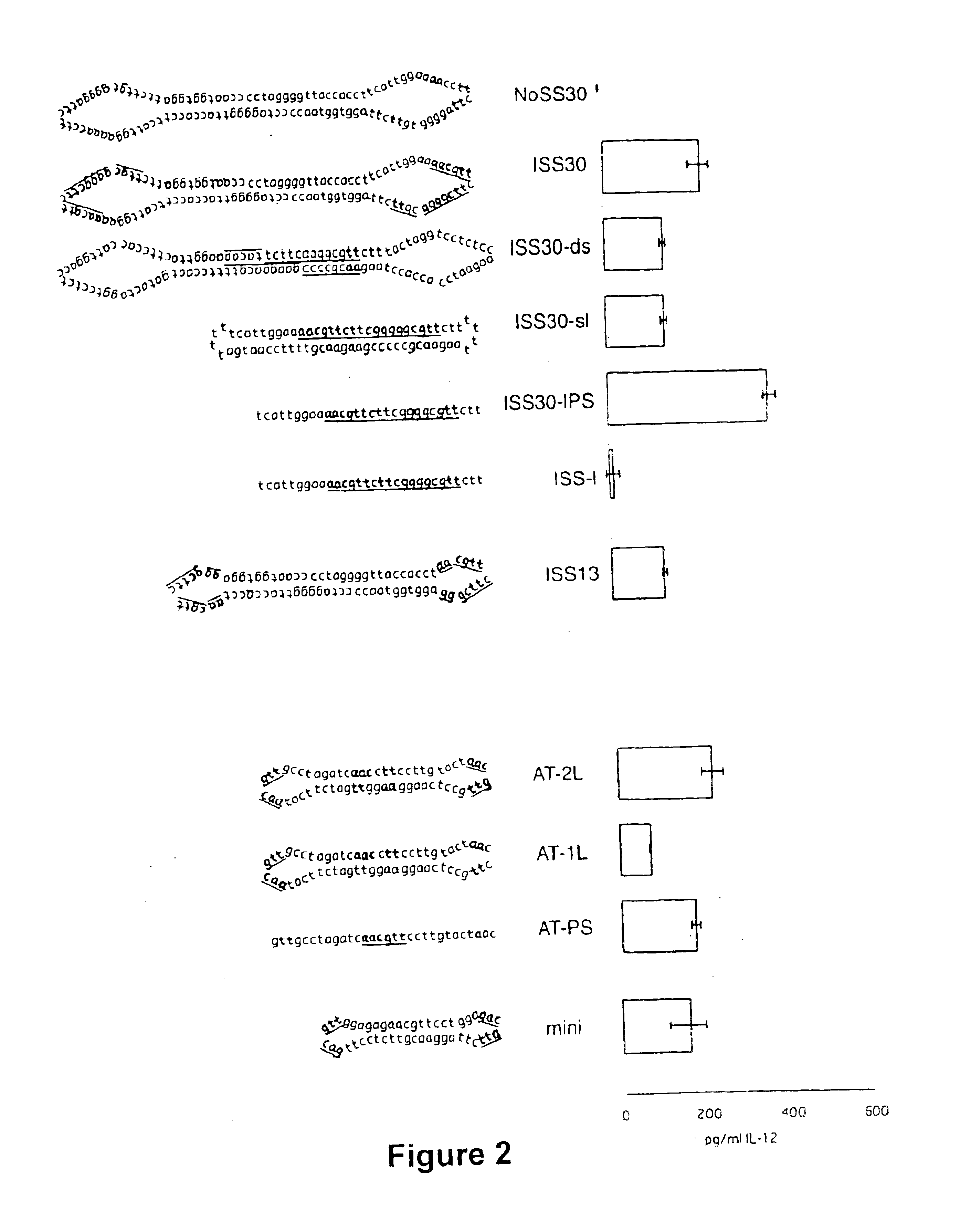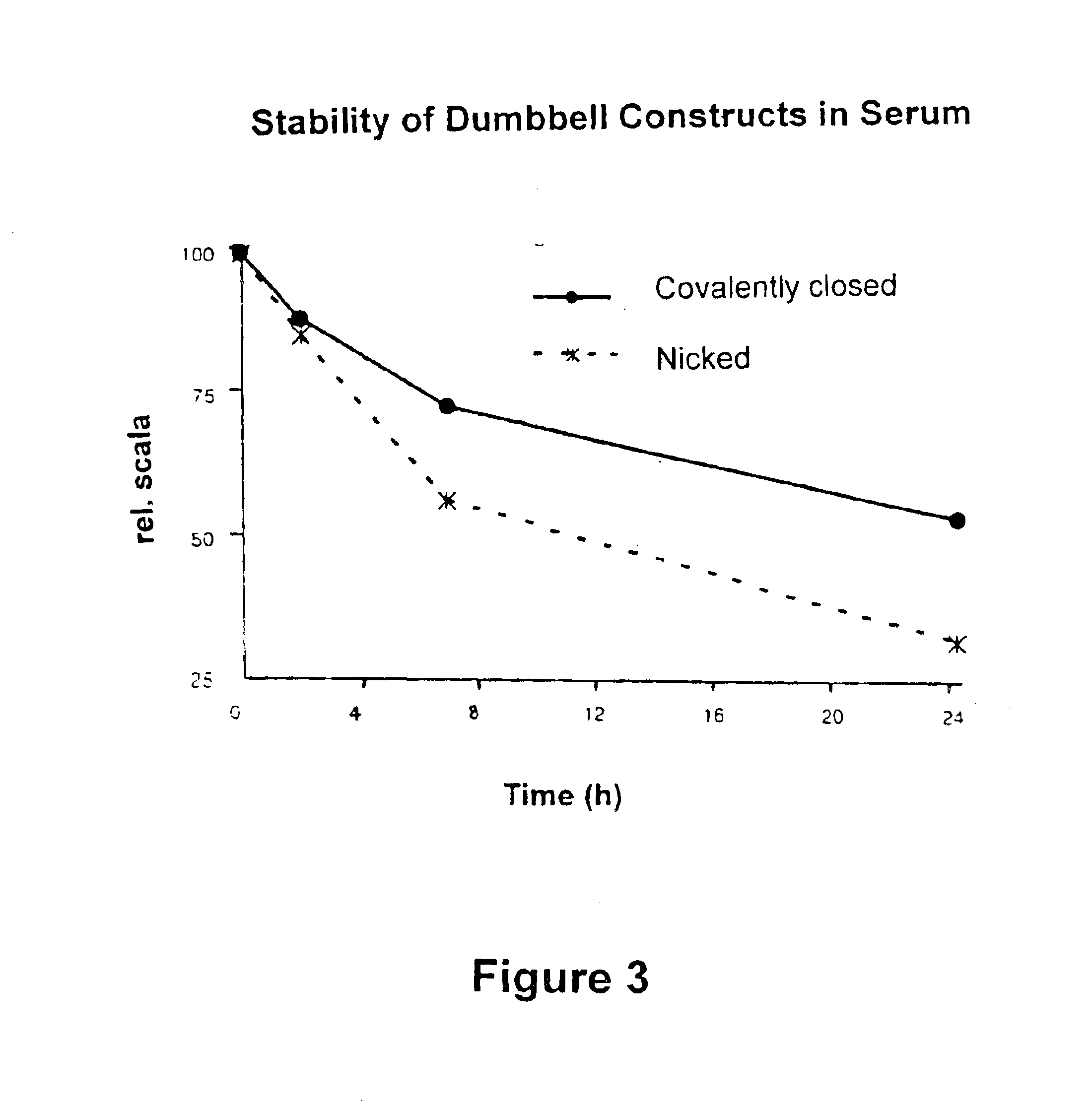Covalently closed nucleic acid molecules for immunostimulation
a nucleic acid and immunostimulation technology, applied in the field of covalently closed nucleic acid molecules for immunostimulation, can solve the problems of toxic to human medical applications, single-stranded iss oligodeoxynucleotides degrade very quickly, and open-chain, so as to suppress the stimulatory effect of iss sequences
- Summary
- Abstract
- Description
- Claims
- Application Information
AI Technical Summary
Benefits of technology
Problems solved by technology
Method used
Image
Examples
example 2
Isolating Spleen Cells and Cell Culture and Cytokine Assays
Spleen cells were isolated from fresh spleens from 5 to 10-week old BALB / c mice (Bomholtgard Breeding & Research Center, Denmark). Two freshly isolated spleens were homogenized using a 40 .mu.m metal filter, and the cells obtained were suspended in 20 ml RPMI 1640 (10% FCS, 100 U / ml penicillin and 100 .mu.g / ml streptomycin, Biochrom, Berlin). Erythrocytes and platelets were removed by gradient centrifugation (Ficoll 1.077; Biochrom, Berlin). The cells were incubated in a final concentration of 10.sup.6 cells / ml at 37.degree. C. in an incubator flushed with 5% CO.sub.2.
10.sup.5 freshly isolated spleen cells were incubated in 96-well plates for 24 hours with the structures produced according to Example 1. The concentration of the structures was equal to 2 .mu.M. The cytokines in the supernatant fluid were measured using the ELISA method (Biosource, Blegium) in accordance with the description given by the ELISA manufacturer. At...
example 3
Serum Stability
5 .mu.g of the deoxyribonucleotide WTO-11-P (phosphate-GAAGAACGTT TTCCAATGAT TTTTCATTGG AAAAC)(SEQ ID NO: 14) (TIB Molbiol) were marked with 75 .mu.Ci gamma-32P-ATP (6000 Ci / mmol) (NEN) in the presence of 10.mu. T4 polynucleotide kinase (MBI-Fermentas, Leon-Rot) according to the manufacturer's specifications. The enzyme was inactivated by heating it to 75.degree. C. over a period of 1 hour. The sediment was purified with water to 50 .mu.l and by a ZG-50 size exclusion tube (Pharmacia). The radioactively marked molecule was converted with unmarked 5'-phosphorylated WOT-10-P (5'phosphate-GTTCTTCGGG GCGTTCTTTT TTAAGAACGC CCC) (SEQ ID NO: 15)(TIB Molbiol) in the presence of 1 U T4 DNA ligase (MBI-Fermentas, Leon-Rot) and 1 mM ATP at 37.degree. C. for 2 hours. Unligated ODNs were removed by subsequent incubation with T7-DNA polymerase. The activity of the obtained preparation (ISS30-sl molecule as in SEQ ID NO: 7) was measured in a scintillation counter (Beckmann Instrumen...
example 4
Administering the Structures in a Mouse
The structures of the present invention were tested in vivo. Six-week old female BALB / C mice were each intraperitoneally injected with 50 .mu.g of the corresponding structures in 250 .mu.l sterile PBS. 50 .mu.l of blood was taken after 2, 6, 24, and 72 hours respectively, mixed with heparin, centrifuged, and the serum was then stored at -70.degree. C. The samples were tested together for IL-12 using the ELISA method (see above). All preparations were tested for endotoxins using the endotoxin assay system (limulus amebocyte lysate (LAL) test, BioWhittaker). All the samples exhibited endotoxin amounts below identified levels.
PUM
| Property | Measurement | Unit |
|---|---|---|
| temperature | aaaaa | aaaaa |
| concentration | aaaaa | aaaaa |
| length | aaaaa | aaaaa |
Abstract
Description
Claims
Application Information
 Login to View More
Login to View More - R&D
- Intellectual Property
- Life Sciences
- Materials
- Tech Scout
- Unparalleled Data Quality
- Higher Quality Content
- 60% Fewer Hallucinations
Browse by: Latest US Patents, China's latest patents, Technical Efficacy Thesaurus, Application Domain, Technology Topic, Popular Technical Reports.
© 2025 PatSnap. All rights reserved.Legal|Privacy policy|Modern Slavery Act Transparency Statement|Sitemap|About US| Contact US: help@patsnap.com



